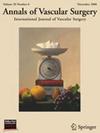炎症状态是非心脏血管手术患者围手术期风险的预测因素。
IF 1.4
4区 医学
Q3 PERIPHERAL VASCULAR DISEASE
引用次数: 0
摘要
简介:计划接受血管手术的患者是术后面临重大心脏不良事件(MACE)风险的重要人群。这是由于一些旨在帮助术后恢复的炎症机制造成的。目前已设计出许多筛查工具,如 EAGLE 风险评分或 Goldman 和 Detsky 评分,以帮助识别高危人群。最近,有人建议将炎症生物标志物作为辅助评估的工具。白细胞介素(如 IL-1 和 Il-6)的作用尤其引起了当前研究的兴趣。我们的假设旨在检验术后测量炎症生物标志物是否有任何益处,以此作为识别有 MACEs 风险的个体的工具:我们确定了75名符合条件的计划接受血管手术(搭桥术、EVAR或开放式AAA修复术或动脉内膜切除术)的患者,并在术前和术后第1-4天测量了四种炎症生物标志物(IL-1、IL-6、ICAM-1和CRP),以确定相关性,并确定发生MACE的患者与未发生MACE的患者之间的差异。MACE的定义是T肌钙蛋白升高0.06或更高,或两名临床医生同意的心电图变化,或中风 结果:在75名患者中,有13人被确定为MACE。结果显示,IL-1 和 ICAM 在术前和术后水平之间均呈显著正相关,其中 ICAM-1 在术后 4 天均呈显著正相关,而 IL-1 在术后第 1、3 和 4 天均呈显著正相关。在比较 MACE 组和非 MACE 组之间炎症生物标志物变化的显著差异时,只发现 ICAM 生物标志物有显著差异。两组之间的 ICAM 在第 1 天和第 2 天有明显差异(t 检验值分别为 0.0455 和 0.0492),但在第 3 天和第 4 天没有明显差异。所有其他生物标志物在手术前后均无明显差异:总之,测量血管手术患者的炎症生物标志物对临床医生识别高危人群有重要帮助,应作为临床医生现有机制的辅助手段。本文章由计算机程序翻译,如有差异,请以英文原文为准。
Inflammatory Status as a Predictor of Perioperative Risk in Patients Undergoing Non-Cardiac Vascular Surgery
Background
Patients scheduled to undergo vascular surgery represent a significant population at risk of major adverse cardiac events (MACE's) post operation. This is due to a number of inflammatory mechanisms, designed to aid in postsurgical recovery. A number of screening tools have been designed, such as the Eagle risk score or the Goldman and Detsky scores, to aid in identification of at-risk individuals. Recently, inflammatory biomarkers have been suggested as a tool to aid in this assessment. The role of interleukins (ILs), such as IL-1 and IL-6, has particularly been of interest to current research. Our hypothesis aims to test whether there is any benefit to measuring inflammatory biomarkers post operation as a tool to identify individuals at the risk of MACEs.
Methods
We identified 75 eligible patients scheduled to undergo vascular surgery (bypass, endovascular aneurysm repair or open abdomnial aortic aneurysm repair, or endarterectomy) and measured 4 inflammatory biomarkers (IL-1, IL-6, intercellular adhesion molecule-1 (ICAM-1), and C-reactive protein [CRP]) pre and postoperatively on days 1–4 to identify correlations and identify differences in individuals who had a MACE versus those that did not. A MACE was defined by a rise in T troponin of 0.06 or greater or electrocardiogram changes agreed upon by 2 clinicians or a stroke.
Results
Of the 75 patients, 13 were identified to have a MACE. The result showed that both IL-1 and ICAM show a significantly positive correlation between pre and postoperative levels, with ICAM-1 significantly positive on all 4 days and IL-1 significantly positive on days 1, 3, and 4. When comparing the significant difference in change in inflammatory biomarkers between the MACE group and non-MACE group, a significant difference was only noted in the ICAM biomarker. ICAM was significantly different between the 2 groups on day 1 and day 2 (t test value 0.0455 and 0.0492, respectively) but was nonsignificant on days 3 and 4. All other biomarkers showed no significant difference pre and postop.
Conclusions
Overall, it is suggestable that measuring inflammatory biomarkers in vascular surgery patients is a valuable aid to clinicians in potentially identifying at-risk groups and should be used as an adjunct to already existing mechanisms available to the clinician.
求助全文
通过发布文献求助,成功后即可免费获取论文全文。
去求助
来源期刊
CiteScore
3.00
自引率
13.30%
发文量
603
审稿时长
50 days
期刊介绍:
Annals of Vascular Surgery, published eight times a year, invites original manuscripts reporting clinical and experimental work in vascular surgery for peer review. Articles may be submitted for the following sections of the journal:
Clinical Research (reports of clinical series, new drug or medical device trials)
Basic Science Research (new investigations, experimental work)
Case Reports (reports on a limited series of patients)
General Reviews (scholarly review of the existing literature on a relevant topic)
Developments in Endovascular and Endoscopic Surgery
Selected Techniques (technical maneuvers)
Historical Notes (interesting vignettes from the early days of vascular surgery)
Editorials/Correspondence

 求助内容:
求助内容: 应助结果提醒方式:
应助结果提醒方式:


